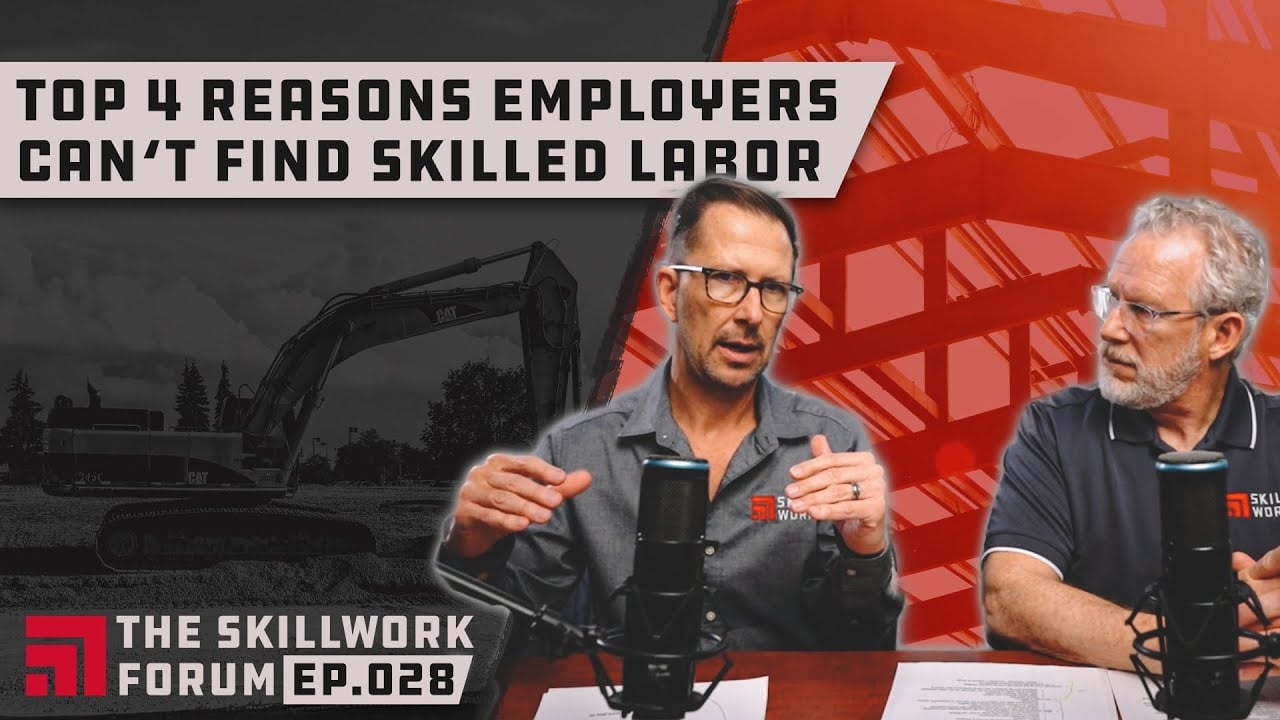Top 4 Reasons Employers Can’t Find Skilled Labor

“Why can’t I find skilled workers?”
We get this question often. It’s no secret that there’s a skilled labor shortage in the United States. In fact, the number one thing keeping business owners up at night is not being able to find quality workers. Companies can’t find the laborers they need to meet deadlines, existing staff are burnt out, and it’s putting increasing stress on their customers.
In this article, we’ll cover the 4 main reasons why companies can’t find skilled labor, including:
- Nationwide shortage of workers
- Outdated recruiting practices
- Evolving skill levels and expertise for workers
- Stagnant or lagging rise in skilled labor wages
The good news is that the workers are out there, and your staffing challenges are solvable. Read on to learn how.
Nationwide Shortage of 1 Million Skilled Workers Will Expand to 2 Million by 2025
Increasing demand and decreasing supply
Changes in supply or demand are challenging enough on their own, but we’re seeing the double-whammy of both occurring simultaneously in the trade sectors. The shortage of workers is undeniable—1 million short of the total need. Unfortunately, that shortage is projected to increase to 2 million in the next 5 years, if not sooner.
Much of the shortage is being driven by baby boomers retiring from the workforce over the next 5-7 years. Unfortunately, the pandemic accelerated that timeline. Many boomers are choosing to take an early retirement or not return to work at all for health reasons. Since they make up a significant majority of the workforce, the already-low supply is continuing to decrease, which has in turn spiked demand for workers.
Automation is decreasing productivity in facilities
Companies are under more pressure than ever to increase productivity.
Currently though, productivity is actually flatlined or decreasing, even though many companies have increased automated technology.
The reason for this is that those highly automated machines require more highly skilled laborers to run and maintain them. It’s more difficult than ever to find laborers, let alone highly specified tradespeople. When companies settle for less experienced workers, it costs more in the long run.
The truth is, putting more workers in a facility doesn’t make you more efficient, it just makes you more expensive if you aren’t hiring the right people.
Pressure to complete backlog of projects but supply of raw materials is low
There’s a huge push to get backlogged projects completed, but plants are having a hard time getting raw material they need in to complete that work. Many facilities rely heavily on offshore materials for at least part of their manufacturing process, and the pandemic significantly impacted those supply chains. As materials become available again, whether for manufacturing or construction projects, there will be enormous pressure to find skilled laborers to complete that work.
Post-pandemic workforce is lagging
The early retirement of boomers from the workforce after the pandemic has reduced the supply of skilled workers. On top of that, many people aren’t returning to work, whether for health and safety, the stimulus bill taking some financial pressure off, or other reasons.
Young people simply not pursuing the trades like they used to
Ultimately, when we look at the future outcomes of the skilled trade workforce, it’s largely dependent on the younger generation. Unfortunately, young people aren’t pursuing the trades like they used to. 20 years ago, it was normal for all high school seniors to consider trade school or apprenticeship instead of a 4 year college degree.
Now, the social norm is for everyone to go to university. The problem is, many young people go down the college route with no strong desire or knowledge of what they want to do with it. It’s vital that we show the younger generations that there is honor and value in a career in the trades.
Not only that, but given the low supply of workers—there is real opportunity for consistent and well-paying work.
Recruiting: Bringing a Sword to a Gunfight
Using old systems and processes to approach the evolving labor problem
Many construction and manufacturing companies truly don’t see how they’re going to find the talent they need. The irony is that many of them continue to use the same hiring practices, like looking for local people with ads in the paper or online, even though those tactics aren’t solving their problem. When that fails to produce results, many companies increase their HR recruiting budgets or hire additional internal talent acquisition people, driving up their costs, only to continue struggling to find workers.
Einstein famously said, “The definition of insanity is doing the same thing over and over and expecting different results”. That’s not to pass judgement—we’re all guilty of it. It’s human nature to go back to what was successful in the past, thinking, “surely this will be the time”. But rather than continue the “rinse and repeat” approach, successful companies will adjust course and pursue innovative solutions to the most challenging problems.
Changing your perspective: light at the end of the tunnel
Here’s the truth, though: the talent is out there.
This isn’t an unsolvable problem, just one requiring a different approach to have success. You can find the skilled workers your company needs, and you don’t even have to sacrifice quality or expertise. There are incredibly talented men and women out there, ready and available to work. You just have to find a way to access them.
Skillwork’s model
At Skillwork, we search nationally to find the best tradespeople and connect them to our clients. We have a specific and targeted approach, and our multi-level vetting process makes our pool of candidates the best of the best. This way, we ensure that each worker-company relationship is mutually beneficial. Our workers have the freedom and flexibility to travel for each gig or stay on long-term with an organization, if desired.
The evolving skilled trade shortage means that your hiring practices need to evolve… and we can help you get there.
Rapidly Evolving Skill Levels and Expertise
The Fourth Industrial Revolution
In our last podcast episode, we talked extensively about the Fourth Industrial Revolution, which will have enormous impacts on the construction and manufacturing industries. Automated machinery, sensors, AI, interconnected ecosystems, and other advancements in digital technology will change the way your company does business.
Just like previous Industrial Revolutions, changing technology will also require workers to evolve and grow their skillsets to be successful. This will exacerbate the staffing difficulties your company is already facing, as the pool of capable people is shrinking as skills evolve.
Increased technology will provide an opportunity to attract a new generation of workers
The good thing about changing technology is that it will create opportunities to attract the next generation to the trades. As AI and technological advancement continues, we see more partnerships between companies and schools or training facilities to encourage more participation and get young people excited about the trades again.
Skilled Workers Are Frustrated with the Stagnation of Their Wages
Traditionally there is a lag in wages when we have economic growth
One of the things we hear from our skilled workers more than anything else is frustration over what they perceive as a stagnation or lagging rise in their wages. Studies confirm this—traditionally there is a lag in wages when we have an economic boom. “Blue Collar” workers are generally the last group to benefit. Fortunately, we are starting to see that trend change in a positive direction, as recent statistics reveal that blue collar wages are experiencing measurable year over year growth.
At Skillwork, we strive to be on the forefront of that change and constantly advocate for the best compensation available to our employees.
Good people always pay for themselves
There can be some pushback from companies on increasing wages for skilled labor, but many are realizing that the days of $15/hr electricians are over. You won’t be able to fight for the best of the best in a shrinking supply of workers if you don’t compensate them with competitive wages or salaries that they deserve.
It’s important to remember that good people always pay for themselves. While it costs more up front to pay a higher salary to a talented worker, it costs much more in lost productivity, extensive training, or reworked jobs to not have those quality workers at your organization.
Invest in the front end cost and give your skilled workers the wage they deserve for the indisputable value that they bring to your company—you won’t regret it.
Conclusion
Unfortunately for skilled workers and companies in the trade sectors, this crisis is only going to get more difficult in the next 3-5 years as the shortage of workers continues to increase. With that in mind, it’s critical that business leaders address this challenge head-on. Long term solutions to the US trade shortage will likely take at least 15-20 years—meanwhile, your business will suffer if you can’t find the people you need.
The good news is, there’s hope. The nursing industry was looking at a similar problem 30 years ago, and out of that, the highly successful travel nursing model was born. While there are still challenges in that sector today, the impact has been greatly minimized through innovative solutions and ideas.
We took their model and adapted it for the skilled trades: finding highly trained, quality men and women and sending them to locations that need them for short- to long-term projects. Not only do we help our clients solve their staffing headaches, but we’re giving opportunity, value, and respect to skilled workers nationwide.
Consider reaching out to us on our website, www.skillwork.com/contact-us for an obligation-free consultation to see how we can help your organization.

